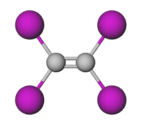| |||
| Names | |||
|---|---|---|---|
| IUPAC name tetraiodoethene | |||
| Other names Periodoethylene, Periodoethene, Diiodoform, Ethylene tetraiodide | |||
| Identifiers | |||
| CAS Number | |||
| 3D model (JSmol) | |||
| ChEMBL | |||
| ChemSpider | |||
| ECHA InfoCard | 100.007.434 | ||
| EC Number |
| ||
| PubChem CID | |||
| UNII | |||
| CompTox Dashboard (EPA) | |||
InChI
| |||
SMILES
| |||
| Properties | |||
| Chemical formula | C2I4 | ||
| Molar mass | 531.640 g·mol | ||
| Appearance | yellow crystalline solid | ||
| Odor | Odourless | ||
| Density | 2.98 | ||
| Melting point | 187–192 °C (369–378 °F; 460–465 K) | ||
| Boiling point | Sublimates | ||
| Solubility in water | Insoluble | ||
| Solubility | Soluble in chloroform, carbon disulphide, benzene and toluene
| ||
| Hazards | |||
| GHS labelling: | |||
| Pictograms | 
| ||
| Signal word | Warning | ||
| Hazard statements | H302, H312, H315, H319, H332, H335 | ||
| Precautionary statements | P261, P264, P264+P265, P270, P271, P280, P301+P317, P302+P352, P304+P340, P305+P351+P338, P317, P319, P321, P330, P332+P317, P337+P317, P362+P364, P403+P233, P405, P501 | ||
| Except where otherwise noted, data are given for materials in their standard state (at 25 °C , 100 kPa). Infobox references | |||
Tetraiodoethylene (TIE), or diiodoform, is the periodinated analogue of ethylene with the chemical formula C2I4. It is a decomposition product of carbon tetraiodide and diiodoacetylene. It is an odourless yellow crystalline solid that is soluble in benzene and chloroform, and insoluble in water. It has been used as an antiseptic and a component in pesticide and fungicide formulations.
Tetraiodoethylene reacts with ethylamine to give ethylamine di-tetraiodoethylene, EtNH2.(C2I4)2, and ethylaminetetraiodoethylene. Tetraiodoethylene and iodine pentafluoride yield iodopentafluoroethane.
Tetraiodoethylene turns brown and emits a "characteristic" odour due to decomposition when exposed to light.
History
Tetraiodoethylene was discovered by Baeyer in 1885. It was proposed as an antiseptic under the name Diiodoform, in 1893 by M. L. Maquenne and Taine. It was an alternative to iodoform which has a strong and persistent odour that caused difficulties for physicians in private practices.
Synthesis
Tetraiodoethylene can be made by the iodination of calcium carbide:
- CaC2 + 3I2 → C2I4 + CaI2
Diiodoacetylene is a byproduct of the reaction which can later be iodinated to TIE.
The action of aqueous solution of potassium hydroxide and iodine on barium carbide in chloroform or benzene can also give TIE. Another synthesis involves mixing separate solutions of diiodoacetylene and iodine in carbon disulphide. Tetraiodoethylene would be left as a residue after carbon disulphide was evaporated.
See also
References
- ^ TETRA-IODO-ETHYLENE, The Pharmaceutical Era. (1897). USA, D. O. Haynes & Company.
- ^ Lide, D. R. (1995). CRC Handbook of Chemistry and Physics. (Special Student Edition): A Ready-Reference Book of Chemical and Physical Data. CRC-Press. Page 522
- ^ Diiodoform in Notes on New Remedies. (1893). USA: Lehn & Fink.
- "Tetraiodoethylene". pubchem.ncbi.nlm.nih.gov.
- ^ Peculiar Decomposition of Diiodoacetylene, Victor Meyel and Wilhelm Pemsel (1896)
- The Code of Federal Regulations of the United States of America (1984). U.S. Government Printing Office.
- Iodine and Plant Life: Annotated Bibliography, 1813-1949. With Review of the Literature. (1950). UK: Chilean Iodine Educational Bureau. page 22
- Action of Tetraiodoethylene on Organic Bases, Chemical Abstracts. (1912). American Chemical Society.
- Journal of the Chemical Society. (1948). page 2188
- ^ New Remedies – Diiodoform in Merck's Market Report and Pharmaceutical Journal: An Independent Monthly Magazine Devoted to the Professional and Commercial Interests of the Druggist. (1894).
- Selections – DIIODOFORM in The International Dental Journal. (1895). USA: International Dental Publication Company.

